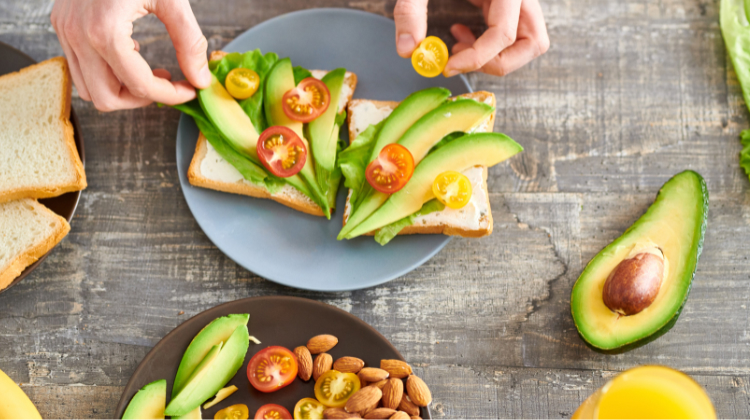Teenage Weight Gain Diet 2024: A Guide For Healthy Weight Gain

The teenage years are a time of prominent physical and mental growth. During this busy chapter in life, it’s not uncommon for teens to burn more calories than they take in. Some may even be underweight as a result. While medical reasons may cause their lack of weight gain, sometimes a teen’s eating habits just can’t keep up with how quickly their body burns calories.
If your teen’s doctor suggests that they gain weight, it’s important to remember that reaching a healthy weight involves more than eating extra calories. It’s crucial to address their immediate nutrition needs, but it’s also essential to nurture a healthy relationship with food.
Teens are exposed to weight loss diets everywhere, but a teenage weight gain diet is not as typical. There isn’t just one way to gain weight; this article will explore various lifestyle changes that can encourage weight gain.
How to Gain Weight as a Teenager
In today’s technology and social media[1] world, teenagers have so much at their fingertips, only furthering the need for instant gratification. Unfortunately, weight changes don’t work that way. While it’s tempting to try to gain weight fast, teens should aim to gain weight through healthy lifestyle choices and develop lean muscle gradually over time.
Yes, you need extra calories to gain weight, but the source of those calories can make a difference in the type of weight you gain.
For example, increasing your calorie intake by eating “junk food,” such as fried and sugary foods, will likely increase your body fat but not build strong muscles and bones.
Eating a balanced diet (which can include less nutrient-dense foods) involves eating adequate protein, choosing high-fiber carbohydrate sources, and including healthy fats. In addition to consuming a well-balanced diet, your teen might also try increasing their strength training and building muscle through resistance training or weight lifting.
A teenage weight loss plan should not include weight loss pills, fat burners, or other weight loss supplements. In the same fashion, it’s recommended that teenagers also avoid weight gain pills. On the other hand, they can consider using weight gainers for teens. Products like protein shakes and protein bars are easy for teens to grab on the go.
Before you start implementing changes in your teen’s diet and wellness routine, remember that the body image they develop in adolescence can follow them into adulthood. Consider adding high-calorie foods to the grocery list and let your teen choose to include them on their own.
You can also increase the calorie density of meals by adding high-calorie ingredients, such as extra-virgin olive oil, mayonnaise, whole milk, and butter if their energy output is high and they need the additional fat calories. Take caution with adding too much-saturated fat as teenagers should limit it to no more than ten percent[2] of their calories, or about 22 grams (g) for a female and 27 g for a male.
Nutrition needs vary between teenagers. Research[3] shows that gender norms play a significant role in body perceptions and desired weight changes. How to gain weight for teenage guys will look different than how to gain weight for teenage girls. Talk with your teen’s doctor to explore the right methods for weight gain for their needs.
If you suspect your teen is struggling with an eating disorder, consult their doctor or registered dietitian.
What is the Ideal Weight for Teens?
The ideal weight for teenagers will vary from teen to teen. In reality, there is a recommended weight range for each age and sex. Growth charts[4] put out by the Centers for Disease Control (CDC) will offer this guidance regarding where your teen falls concerning average weight.
While these ranges are helpful guidelines, remember that the number on the scale does not necessarily determine health. The more pressure your teenager puts on themselves to reach a number on the scale, the more it affects their quality of life.
When underweight, it can be challenging to build muscle and maintain bone mass[5]. It also puts you at risk or negatively affects your immune system. If your teen is losing weight unintentionally, discuss potential root causes with their doctor and a registered dietitian.
5 Effective Tips for Teens to Gain Weight
When a teenager’s nutritional intake just can’t keep up with their metabolism, gaining weight can be difficult. The best way to encourage weight gain for your teen is to help them develop eating habits that will serve their health for the rest of their life. These small changes can significantly impact their weight, muscle mass, and bone mass. To safely and gradually gain weight, consider helping your teen:
Eat More Calories

Gaining weight happens when you eat more calories than you burn throughout the day. The calories you don’t use for energy get stored in your body for times when you may not get enough to eat. Your teen can eat more calories by
- Eating more frequently
- Adding tub margarine, avocado, cheese or mayonnaise to sandwiches
- Including full-fat dairy products
- “Double-dressing” meals (i.e., adding more olive oil, cream sauces, etc.)
Build Muscle Mass

Muscle mass is denser than body fat. Building muscle mass is a healthy way to gain weight, even if it doesn’t necessarily show in size. Exercise needs vary from teen to teen, but resistance training is an excellent way to develop healthy, lean muscle. Research[6] also indicates resistance training offers other benefits such as improved self-esteem, lower risk of sports-related injury, and increased bone strength.
Bulk Up the Snacks

An efficient way for your teen to increase their daily calorie intake is to eat more calorie-dense, healthy snacks. Snack ideas include
- Apple slices and peanut butter
- Trail mix
- Chicken salad sandwich
- Avocado toast.
- Nuts and seeds
There are endless snack options, so don’t overthink it!
Increase Your Protein Intake

Protein foods are a critical part of a balanced diet and essential for building healthy muscle. Examples of quality protein foods include
- Lean meats
- Eggs
- Fish
- Beans
Consider a Bedtime Snack

Eating a nutritious snack before heading to bed can help your teen boost calorie intake by squeezing in one more. Some ideas for a bedtime snack include
- Peanut butter toast
- A bowl of whole-grain cereal with whole milk
- Pita bread, and guacamole
Not all, but some of the same budget-friendly tips for losing weight can also apply to gaining weight for teens. Buying foods in bulk, enjoying home-cooked meals, utilizing leftovers, and making your own protein bars are just a few ways to save your wallet while boosting your nutrition intake at home.
What to Avoid for Healthy Weight Gain?
When working towards a change in body weight, whether it be weight gain or weight loss, it’s critical that you maintain a healthy perspective. Your teen’s nutrition regimen should never leave them feeling like they’re not good enough. What they eat shouldn’t feel like a punishment.
Instead, encourage them to make choices that support their health and empower their development. Help them make choices that meet their nutrition needs in the “here and now” while also preparing them for a life of good health.
Some things to avoid when trying to gain weight:
- Skipping meals
- Skipping physical activity
- Feeling discouraged
- Skipping food groups
A balanced diet can include healthy foods and “junk food.” However, some foods should be consumed in moderation. Items such as fried foods, energy drinks, fruit juice, and candy are high in calories but not much else. You don’t need to avoid them, but consider eating them only on occasion.
The Takeaway
Teenagers are an active population, and occasionally their calorie intake can’t keep up with how quickly their bodies burn energy. If your teen needs to gain weight, the best thing you can do is guide them to make healthy decisions about their own body. The goal is not to gain weight fast but rather to incorporate weight gain into their normal growth pattern.
Weight gain for teens is not a one-size-fits-all diet. The key to successfully gaining weight while protecting their body image is incorporating extra calories and healthy snacks into their routine. Allow them to make decisions and keep an open conversation with them. Discourage them from following fad diets that promise fast results, and help them remember that they can gain weight gradually with nutritious food.
There is undoubtedly a place for processed foods, especially for teenagers who are constantly on the go. Don’t be alarmed if your teenager wants to eat “junk food” for some extra calories every now and then. A healthy snack option doesn’t have to be elaborate. It can be something as simple as an apple with peanut butter or dinner leftovers.
This article does not take the place of medical advice. Working with a doctor when making lifestyle changes regarding health concerns is essential. Also, if you suspect your teenager is underweight as a result of an eating disorder, it’s critical that you speak with their doctor or registered dietitian to seek individualized care.
+ 6 sources
Health Canal avoids using tertiary references. We have strict sourcing guidelines and rely on peer-reviewed studies, academic researches from medical associations and institutions. To ensure the accuracy of articles in Health Canal, you can read more about the editorial process here
- Jiotsa, B., Naccache, B., Duval, M., Rocher, B. and Grall-Bronnec, M. (2021). Social Media Use and Body Image Disorders: Association between Frequency of Comparing One’s Own Physical Appearance to That of People Being Followed on Social Media and Body Dissatisfaction and Drive for Thinness. International Journal of Environmental Research and Public Health, [online] 18(6), p.2880. doi:10.3390/ijerph18062880.
- Healthy Eating | SF Gate. (2012). Percentage of Fat a Teenager Should Have a Day. [online] Available at: https://healthyeating.sfgate.com/percentage-fat-teenager-should-day-3065.html
- Nagata, J.M., Domingue, B.W., Darmstadt, G.L., Weber, A.M., Meausoone, V., Cislaghi, B. and Shakya, H.B. (2020). Gender Norms and Weight Control Behaviors in U.S. Adolescents: A Prospective Cohort Study (1994–2002). Journal of Adolescent Health, [online] 66(1), pp.S34–S41. doi:10.1016/j.jadohealth.2019.08.020.
- Anon, (2022). Growth Charts – Homepage. [online] Available at: https://www.cdc.gov/growthcharts/index.htm
- Bialo, S.R. and Gordon, C.M. (2014). Underweight, Overweight, and Pediatric Bone Fragility: Impact and Management. Current Osteoporosis Reports, [online] 12(3), pp.319–328. doi:10.1007/s11914-014-0226-z.
- Myers, A.M., Beam, N.W. and Fakhoury, J.D. (2017). Resistance training for children and adolescents. Translational Pediatrics, [online] 6(3), pp.137–143. doi:10.21037/tp.2017.04.01.



